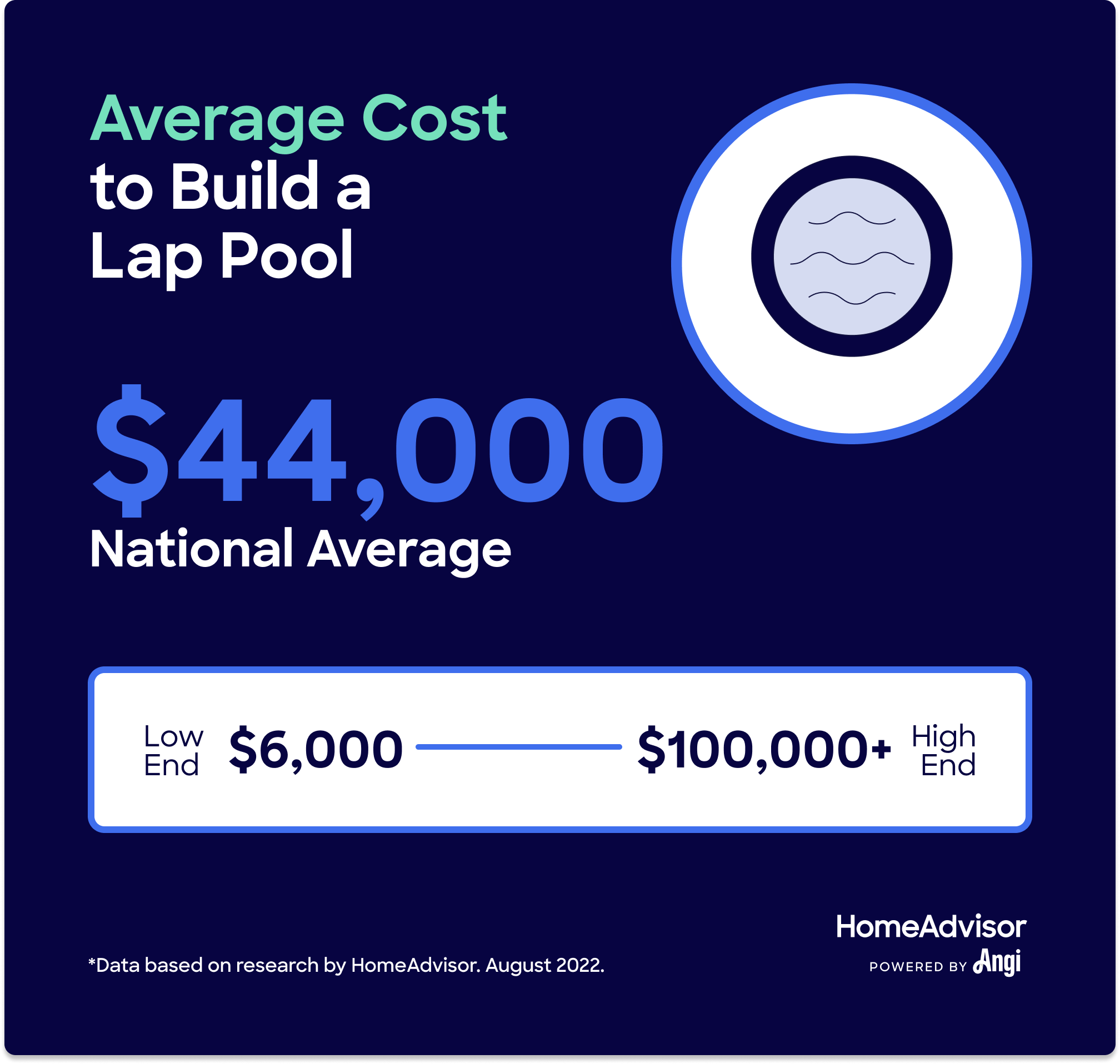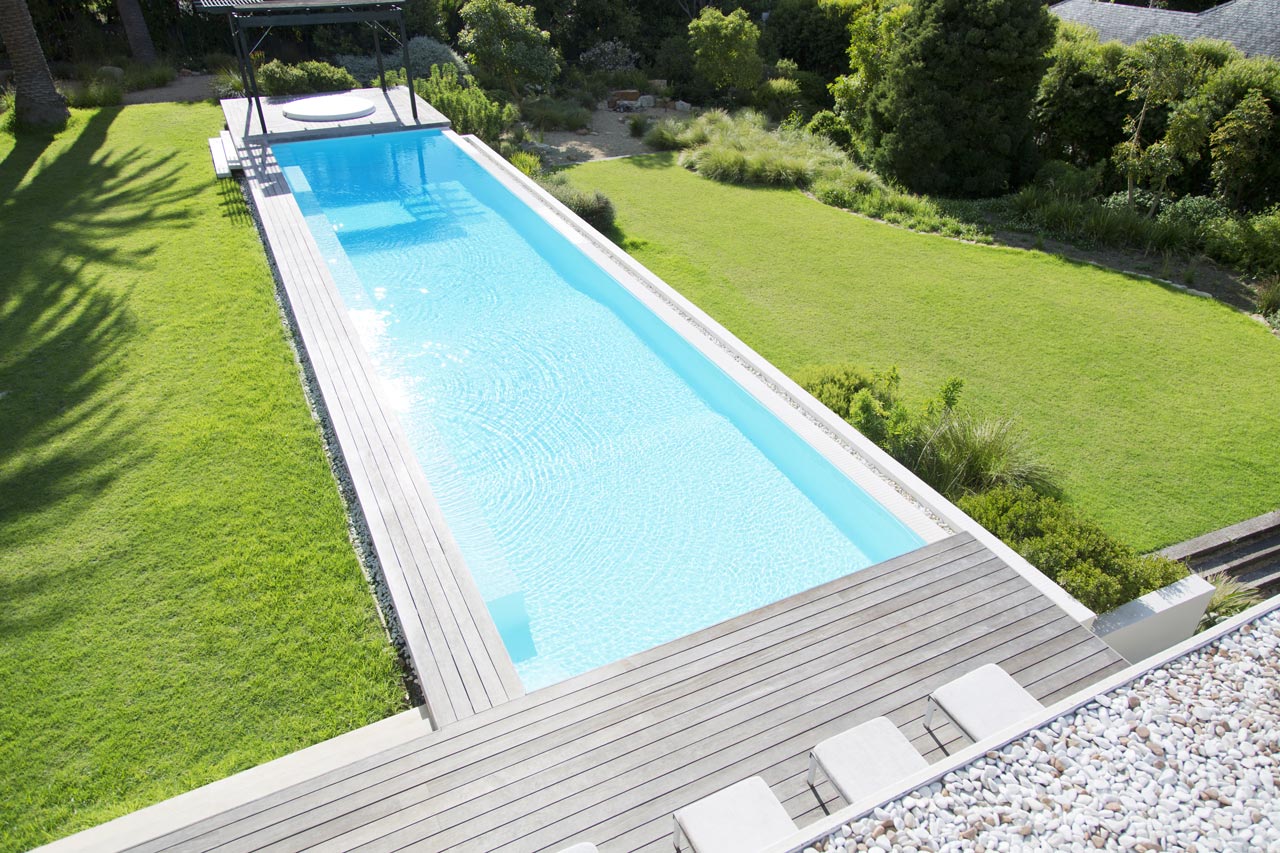How Much Does a Lap Pool Cost?
Typical Range:
$4,000 - $100,000
Typical Range:
$4,000 - $100,000
Cost data is based on research by HomeAdvisor.
Updated April 15, 2024
Written by HomeAdvisor.Hiring a pro for lap pool installation ensures safe and accurate work, especially for complex in-ground models.
The average cost for an in-ground lap pool is around $50,000, while above-ground models typically run you $6,000.
Pool size, whether it's above or in-ground, labor costs, and material type significantly impact the cost of the project.
Materials for lap pool construction include vinyl, resin, fiberglass, and concrete.
Considerations for a lap pool project include available space, desired size, maintenance requirements, and potential increase in home value.
A home lap pool offers exercise convenience and uses less space, water, energy, and has lower installation and maintenance fees than a standard-sized pool.
Highlights were summarized from this existing cost guide text using automation technology and were thoroughly reviewed for accuracy by HomeAdvisor Editor Ryan Noonan.
Installing a home lap pool will cost you an average of $44,000 after materials and installation. However, you could pay $6,000 on the low end and $100,000 on the high end.
Labor charges will be comparable to traditional installation, running $5.50 per square foot, and totaling $3,800 for a 40-by-8-by-4-foot average-size unit. Materials vary greatly, but average at around $56 per square foot, or $39,000 total.
The three main sizes for lap pools are standard in-ground pools, half Olympic, and full Olympic-sized pools. Here's what you can expect to pay for each.
| Lap Pool Size (Feet) | Lap Pool Size (Meters) | Average Cost |
|---|---|---|
| 40 ft | 12.192m | $45,000 |
| 82 ft | 25m | $100,000 – $400,000 |
| 164 ft | 50m | $300,000 – $500,000 |
Here are some cost factors to consider when determining the cost to build a pool.
The size of your lap pool will directly affect cost. Forty feet is a standard size for homeowners with a moderately sized backyard. A 25-meter "short" course will nearly double the cost. For an Olympic-sized 50-meter in-ground pool, you are likely starting in the low- to mid-six figures range from a cost perspective.
Above-ground lap pools are less common, as they need to be shaped longer than a traditional above-ground pool to accommodate your workouts. That said, they start as low as $6,000. For an in-ground pool, you're likely looking at at least a five-figure investment.
Labor costs to build a lap pool are the same as the labor rate for traditional models, or $5.50 per square foot. For an average 40-by-8-by-4 unit, this would be $3,800. The more complex the project, the higher the labor charge.
Things that can increase this total include:
Excavation complications like removing large vegetation or other obstructions.
Extras like elaborate tile surfacing requests.
Adding special features, such as a mirror-style infinity pool or zero-entry access.
Installation should take roughly one month for vinyl, six to eight weeks for fiberglass, or three to five months for concrete, assuming you have not excavated land.
Materials make up the bulk of any lap pool investment you make. Roughly $39,000 of the aforementioned $44,000 estimate for a 40-foot pool will be the result of materials.
Building a pool sometimes requires a permit, depending on your state or city. Expect to pay between $500 and $1,000 for a pool permit.
Digging and backfilling a 40-foot pool costs $1,000 to $1,500 on average. If you're digging in an area with lots of roots or vegetation, or obstacles that need to be removed, the cost may increase.
The cost of installing a saltwater pool includes the price of the pool plus the saltwater-chlorine generator, which runs $500 to $2,500. Overall, you will spend less on chlorine and maintenance, as these systems tend to keep surfaces cleaner longer.
Some parts, such as vinyl lining, stone coping, steel ladders, and O-rings, could corrode if used in saltwater. Talk to a pro if you’re considering this alternative.
There are affordable and pricey ways to heat your pool. With a solar cover, for example, you may only spend $2,000 and have a device that can heat your pool going forward.
An electric heat pump or resistance heater, on the other hand, may cost as much as $7,700.
Lighting a pool, on average, costs $450 to $650. This includes materials and installation.
Safety covers start around $1,000 for lap pools. For one that offers solar benefits, you might pay as much as $3,000.
If you have small kids, for example, you might need to factor in the cost to build a fence around your lap pool. This could cost an additional $2,000 for even a basic wire fence.
Pool accessories can range greatly depending on what you need. A skimmer costs around $100, but you'll need one to keep your workouts leaf and bug-free.
Expect to pay $4 to $12 per square foot for landscaping. Some homeowners install gravel around their pool area to make it easier to mow their lawn.
The design of your lap pool can greatly change the price you'll pay. From in-ground and above-ground to more high-end variations, here's what you can expect in terms of cost.
In-ground lap pools average $50,000. This is for an average 8-foot-by-40-foot and 4-foot-deep structure. Prices can vary depending on the materials used during installation. Each pool manufacturers’ products will vary slightly, even for similar models.
Above-ground models typically run $6,000 with labor included. This amount is for a vinyl model, which you could assemble yourself to lower the price to a few thousand dollars.
Resin and fiberglass options are also available for $3,000, not including labor. These are restricted in length to 45 feet max. While most units are oval-shaped, there are some rectangular models available for lap swimmers.
The cost of an indoor lap pool is, on average, $50,000 for in-ground and $6,000 for above-ground—roughly the same as the outdoor version with a few expenses added on.
Added expenses for an indoor pool include:
Dehumidifier system: $200–$5,000+
Building permit charges: $500–$1,000 (more if making structural changes)
The cost of installing an in-ground infinity lap pool runs around $80,000. Totals include labor, which runs around $1,550 to $2,500. An above-ground version is less expensive, running between $1,700 and $6,000. Build time is 12 weeks for an in-ground model and around one week for above-ground.
There are three types, including:
Infinity: One edge “disappears,” making it look like the water extends forever in certain conditions.
Mirror: All edges disappear into the ground, and the deck sits directly next to the edge.
Endless infinity: Has both an infinity edge and an endless/stationary system installed.
The real financial burden here is the cost to run and maintain it, which is higher than a traditional pool. Because the water is continuously running, electricity bills are high. Evaporation also increases water and chemical usage.
You’ll pay $500 to $2,500 for a saltwater generator, in addition to the cost of the pool.
Endless lap pools (or “stationary lap pools”) are a good alternative to a full-length model and start at about $24,000. There are many options, but typically they are 9-by-14 feet.
Benefits include:
Lower energy and utility bills
Less water and chemical usage
Space-saving
Require less maintenance
Easily built indoors
How you maintain your pool depends on the type and system you install. Outdoor, larger models will require more maintenance and chemical input than a smaller, indoor system.
Things you will need to maintain include:
Water levels: Levels change due to evaporation and excessive rain.
Chemical levels: You’ll need to check chlorine and salt, depending on your system type.
Waterline tile: Regular cleaning prevents permanent staining and replacement needs.
Skimmer: You will need to empty this when leaves and other items get stuck.
Pool vacuum/chlorination system: These systems reduce regular maintenance, but will need repair if they break.
Surface: Check with the manufacturer on how to best clean your specific surface material.
Having a pro install a lap pool can range from $6,000 to over $100,000, depending on the model and location you choose. Labor itself is a significant portion of the total, mainly for in-ground installs, at almost $40,000 for the whole project.
While an exceptionally skilled homeowner (and several friends) could complete the work themselves, we recommend that you leave it to a seasoned contractor.
Above-ground models are much easier to install because they do not require specialized skills or tools. You could end up spending as little as $3,000 for a vinyl above-ground pool if you have the expertise to finish the work safely and accurately. Still, even this is a job for only a highly skilled homeowner.
The major benefit of a home lap pool is the convenience of exercise and not having to travel somewhere to swim.
A smaller version is especially beneficial compared to a normal-sized pool because it uses less:
Space
Water
Energy
Installation and maintenance fees
The space needed for a lap pool depends on the type you install.
Traditional: 50-by-10 feet (40-by-8-foot pool with room for decking)
Stationary/endless: 8-by-15 feet
Forty feet is the baseline you should consider unless you're thinking of using an endless pool. Ask a local pool builder to give you suggestions on the right size for your space and budget.
Whether a lap pool is worth it will depend on your needs and wants. If you want to exercise at home in your lap pool without having to go to the gym, it could be a great investment for you.
However, lap pools need to be longer than the average swimming pool, which means you’ll need more space in your backyard to accommodate one. On average, lap pools should be 40-feet long to get a good workout.
Adding a pool to your home can raise its value by 7%. However, the materials you use and how well you maintain it will heavily play into its ultimate ROI. Keep in mind that buyers with young children may steer away from homes with lap pools, as well as anyone looking for a standard pool.

